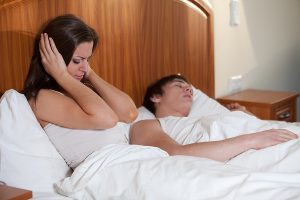 Snoring and Sleep Apnoea are very closely linked and both have effects on your and your partners sleep.
Snoring and Sleep Apnoea are very closely linked and both have effects on your and your partners sleep.
A single apnoea is a complete or partial blockage of the airway that lasts for ten seconds or more. It is ‘normal’ to have around 5 of these events per hour but once the frequency increases it can have quite a dramatic effect on ones sleep and ultimately the waking life of the sufferer.
Although not all snoring is considered to fall under the apnoea umbrella, it is generally a very strong indicator for sleep apnoea as the process of snoring is vibrations within the airway that interrupts the delivery oxygen into our system.
A typical sequence of Apnoea would be:
A blockage in airway for 10 seconds or more
Restriction of airflow
Drop in Blood oxygen levels
Chemo receptors picking up on this and sending signal to brain
Brain releasing adrenalin and cortisol causing us to wake up to take a breath (often seen as gasping)
Fall back asleep and process starts again.
Sleep Apnoea is a two pronged sword. Firstly the drop in blood oxygen levels causes stress for the heart and the cardiovascular system. The release of Adrenalin and Cortisol is believed to have effects on blood pressure and cause fluctuations on heart rate throughout the night. This can explain why patinets often report waking unrefreshed or waking with a headache.
The arousals that come with sleep apnoea also effect our sleep stages. The constant interruptions mean that we find it very difficult to progress through the sleep stages meaning we miss out on the benefits of the ‘deeper’ stages of sleep. This to can explain why patients wake feeling unrefreshed or find that they are quite drowsy early in the day.
While it is often laughed about, snoring and sleep apnoea can have effects on bed partners sleep and relationships as well. It is quite common for couples to sleep in other rooms because of snoring. If partners brave the barrage and stay with a snorer their nights are often interrupted by the sheer noise of a snore or with the anxiety of worrying whether there partner is going to take another breath.
When talking to my patients I use a few different analogies to explain the effects of sleep apnoea. The reason I use everyday is examples is that we often forget that sleep does comprise around a third of our lives and is rarely put in context.
Firstly to explain the drop in oxygen levels I get my patients to imagine that we do not need sleep. I then get them to think about how it would feel to hold their breath for the amount of time they are holding their breath for in their sleep for an hour period and imagine how that would make them feel. I don’t recommend doing this but I often hold my breath for 15 seconds for 5 minutes in a row to demonstrate to patients what is actually happening. It is quite a panicky experience after just 5 minutes.
Another analogy I use to explain the arousals is the 8 hr work day. A good 8 hour work day we are sitting at our desk working away without the phone or anybody interrupting us allowing us to get absorbed in our work productively. Now imagine someone popping there head in your office every 2 minutes to ask a quick question then getting back to work. Your work would be hard to maintain as you are constantly interrupted and the interruptions would also take away from the total time working.
When comparing a ‘normal’ persons night sleep to a person suffering from sleep apnoea it is quite remarkable the difference in terms of arousals and also time breathing. It is this reason why when patients go onto treatment they feel so much better.
